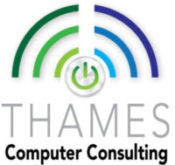UPDATE: This post was updated on August 16, 2020.
How much is your data worth to you? If your hard drive crashed or if you lost your device – would losing the data upset you? Of course it would! You have pictures, emails, documents, music – your whole life is on that thing!
It’s not a question of “if” your hard drive will fail, it’s really a question of “when.” Hard drives are the most sensitive pieces of equipment on a computer. They are essentially floating platters that spin at high speeds with a head that moves back and forth over the platters. (UPDATE: This was written when spinning hard drives were all we had. Now we have solid state drives which are not spinning platters but when they fail, data is usually not recoverable except by an expensive data recovery company. All the more reason to have a reliable backup.)
BACKUP BASICS
- Have 2-3 copies of all your important data. One copy on your computer, one on an external drive, and one in the cloud.
- Ideally, one of your backups is not local. It is stored in another location in case of a problem in your home/office. Cloud backup services such as Carbonite are a perfect solution for off-site backup.
- Do not use CD/DVD’s as backup. They are not reliable in the long run and technology is moving away from these discs.
- Set up a backup plan that you will use! This doesn’t have to be hard.
- Not everything has to be backed up. Your 100 GB music collection can most likely be recreated if need be.
- Backup all your electronic devices – mobile devices as well as desktops/laptops.
- Backup regularly.
- Test restoring data to make sure backup is working.
TYPES OF BACKUP
- Local – This means using an external hard drive plugged into your computer or a NAS (Network Attached Storage) that plugs into your router and allow all computers on your network to use the drive for either backup or storage.
- Off-site – Your home or business could suffer some kind of damage that would render your computer and your external hard drive useless (think flood or fire.) Nowadays, off-site storage is the “cloud.” This is a great alternative for laptops since you don’t have to plug an external drive.
CLOUD STORAGE VS. CLOUD BACKUP
What I often hear is people saying “Oh, I use the iCloud/Dropbox/Google Drive, my data is backed up already.” There are significant differences between cloud storage and cloud backup. Free cloud storage applications are great for several things—organizing pictures by vacation, baby, or DIY project; sharing these memories with family and friends; allowing for easy access to these files across multiple devices. Read more about backup here.
What cloud storage applications should not be confused with is secure backup. Cloud storage applications do not provide comprehensive, automatic backup of all files on your computer. As such, the user is unable to set policies for data retention, including what’s backed up and how frequently. They’re also poor protection against one of the most common forms of data loss—user error and accidental deletion. If you delete something stored only on the cloud, it’s usually gone.
Examples of Cloud Storage:
- iCloud
- Google Drive
- Dropbox, Box, etc.
- One Drive
Examples of Cloud Backup:
- Carbonite
- Backblaze
- Crashplan
Some backup suggestions:
- Carbonite – For $60/year, get unlimited storage space in the cloud. Carbonite installs a program on your laptop or desktop that quietly runs in the background and keeps your computer backed up. Incredibly easy to set up and use. The first backup takes a long time but after that only changed data is backed up. Works with Windows or Macs.
- File History – Windows 10 has a built-in backup and restore program that works with your external hard drive.
- Time Machine – Mac OS X comes with a program that will automatically back up your data when you plug in an external hard drive. Time Machine saves multiple copies of your files so you can go back through versions to find a file you accidentally deleted.




